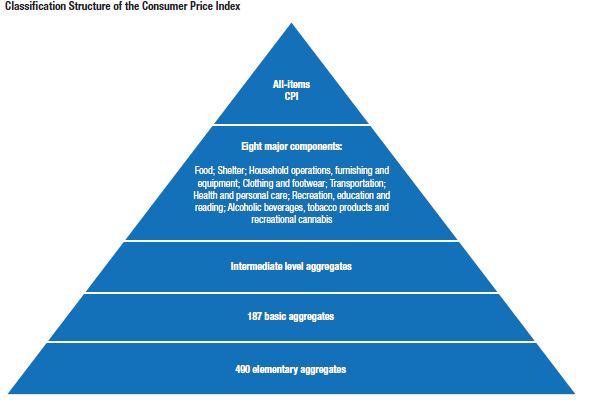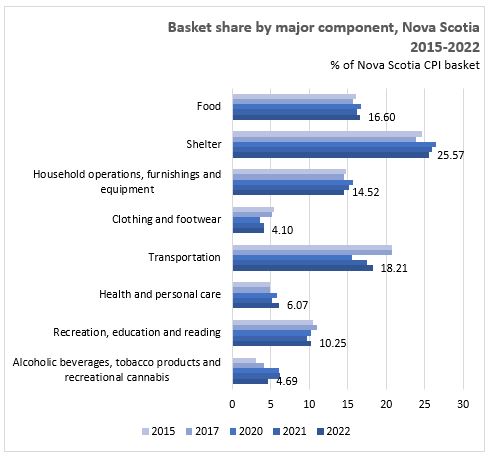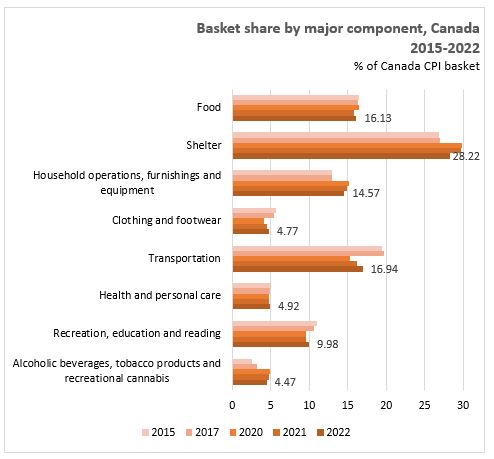The Economics and Statistics Division maintains archives of previous publications for accountability purposes, but makes no updates to keep these documents current with the latest data revisions from Statistics Canada. As a result, information in older documents may not be accurate. Please exercise caution when referring to older documents. For the latest information and historical data, please contact the individual listed to the right.
<--- Return to Archive
For additional information relating to this article, please contact:
June 20, 2023CONSUMER PRICE INDEX 2023 BASKET UPDATE Statistics Canada has released their regular update for Consumer Price Index (CPI) basket weights and composition, available here. The updated basket weights will be used with the release of May 2023 CPI on June 27, 2023.
CPI basket quantities are fixed to the reference period of the basket weights which are used to estimate consumer expenditures for the upper-level aggregation. Larger weights represent a large share of expenditures on the category and the more a price change will impact headline CPI. For 2022, the expenditure weights are derived from household final consumption expenditures data and a variety of supplemental sources. Updating the basket is needed as expenditure patterns shift in response to prices, income levels, demographics, habits and new technology/products.
In 2022, spending was shifting back towards pre-pandemic patterns compared to 2021 and 2020. Spending on transportation, travel and dining out recovered to a greater extent in 2022 compared to 2021. Canadians also were adapting to more hybrid work rather than full-time at home. Commodity prices for gasoline and wheat-based food products increased expenditures following Russia’s invasion of Ukraine.
Each good or service in the basket is assigned a basket share proportional to consumption expenditure for which they account. The CPI classification of goods and services is organized according to a top-down hierarchical structure from the eight major components to 490 elementary aggregates that are not all published and are added or deleted as consumption pattern changes. At the elementary aggregate level, the classification includes sample of items that characterize all products in the class. Representative products are chosen for items that are widely available and known to be among the most popular with consumers.

Changes for the 2023 update include making some elementary aggregates into basic aggregates to provide more granular data. At the national level, other fresh fruit will be separated into citrus (excluding oranges), grapes, and berries (including cherries) and other vegetables will be separated into carrots, onions, peppers, cucumber and mushrooms. A cellular service index will be published at the provincial level. Homeowners’ maintenance and repair index was streamlined to reduce unnecessary details. Some products are being deleted including home telephones for land lines, DVD players, DVD records and video cameras. New products that will be added include charcoal barbecues, small appliances for food/beverage preparations, snow removal equipment, and infant/baby hygiene products. With the 2023 basket update, the expenditures for cannabis in the illicit market will no longer be included.
Nova Scotia basket weights for food is up 0.41 percentage points to 16.60%, above pre-pandemic levels. Transportation share rose 0.68 percentage points to 18.21% but remains below pre-pandemic levels of over 20%. The largest increase in basket weight is in health and personal care with a 0.96 percentage point increase to 6.07 of expenditures. Recreation, education and reading was up in 2022 after declining in 2020 and 2021. The shelter component weight was down again in 2022 with a 0.42 percentage points to 25.57%, although still above it’s pre-pandemic weight. Household operations, furnishing and equipment fell 0.62 percentage points to 14.52%, a similar weight as pre-pandemic. The largest decline in weight was for alcoholic beverages, tobacco products and recreational cannabis as it declined from over 6% in 2020 and 2021 to 4.69% in 2022.

Relative to Canada, Nova Scotia CPI basket weights are higher in food (+0.47 percentage points), transportation (1.27 percentage points), health and personal care stores (+1.15 percentage points), recreation, education and reading (+0.27 percentage points), and alcoholic beverages, tobacco products, and recreational cannabis (+0.22 percentage points). Nova Scotia expenditures weights are lower than Canada in Shelter (-2.65 percentage points), household operations, furnishings and equipment (-0.05 percentage points), clothing and footwear (-0.67 percentage points).

Sources:
Statistics Canada. An Analysis of the 2023 Consumer Price Index Basket Update, Based on 2022 Expenditures
Statistics Canada. Table 18-10-0007-01 Basket weights of the Consumer Price Index, Canada, provinces, Whitehorse, Yellowknife and Iqaluit
<--- Return to Archive